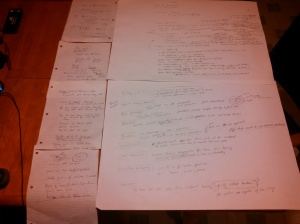In the article linked below I explore connections between two articles, “The Role of Assessment in a Learning Culture” by Lorrie Sheppard and “Inside the black box: Raising standards through classroom assessment” by Paul Black and Dylan Wiliam. They both are discussing how assessments can be used in the classroom to make for a better learning environment. My discussion of the two focuses on their similarities and how their application of a new environment for learners is also an environment that is required for teachers if they intend to implement their recommended practices.
Please feel free to comment!!
Thanks
Larry
Thematic Connections between The Role of Assessment in a Learning Culture and Inside the black box: Raising standards through classroom assessment
The two reports presented information on how shifting towards formative assessment could improve student learning. Both reports agree that students need to be active in the assessment process and that it should not be something that is handed down from the teachers. They also both agreed that the ultimate goal is to get students to understand the material and those students benefit when immersed in a culture of success that recognizes that all learners can learn.
For policy reform and implementation, both articles suggest that teachers and students would perform better in environments designed for formative assessment. Lorrie Sheppard’s article in regards to the “Assessment in the Process of Learning” mentions that, “In addition to using assessment to monitor and promote individual students learning, classroom assessment should also be used to examine and improve teaching practices.” Sheppard included in this process the creation of a learning culture, dynamic-ongoing assessments, focusing on prior knowledge, feedback, transfer, explicit criteria, and self-assessment as essential parts to make learning happen, and likewise, the same process can be used to create learning for teachers. Similarly, Black and William’s article indicated that implementation of change is impeded by the teacher’s unwillingness to move theory into practice and that in order to do this there must be the building of a social component, and also the ability to reflect on the quality of their work. They want to say that all teachers can teach, but only if the teachers receive the kind of support that makes for a preferred learning environment.
The articles suggest that both students and teachers could benefit with purpose and rationale as the primary drivers for assessment. Once there is a particular purpose defined an assessment can be done to indicate a “present position” or state of “prior knowledge” then the learners and teachers need to be given information on how to “close the gap” or what “explicit criteria” is needed to proceed.
Both articles highlighted the importance of not oppressing students through improper feedback. Students should work out their problems in their own without teachers rushing the answers. The maintenance of student’s motivation and self-confidence were also critical. Motivation can be achieved by helping students view a problem differently, or by asking questions that led them to ask the right questions rather than telling them that they are wrong, or giving them the answer that teachers want them to have.
If students have a zone of proximal development then so do teachers, if teachers can teach full classrooms under various levels of stressful situations just imagine what they could do with a little help? Black and Wiliam state in their policy reform program that, “Schools involved would need extra support in order to give their teacher time to plan the initiative in light of existing evidence, to reflect on their experience as it develops, and to offer advice about training others in the future.” External trainers although limited overtime will have had the necessary support to test and create methods to share with other teachers that are teaching in similar contexts.
Nobody wants to be judged by an external force. Sheppard indicates that students do best when they take control of their evaluations, and likewise, Brown and Wiliam indicate that external evaluations judgments lead towards the pursuit of the simplest task. Both articles agree that these types of external evaluations of both student and teacher performance leads towards non-motivated participants that pursue the simplest task which is often standardized testing and the abandonment of real educational advancement.
References:
Black, P., & Wiliam, D. (1998). Inside the Black Box: Raising Standards through Classroom Assessment. American Education Research Association, 80(2), 139-148.
Sheppard, L. (2000). The Role of Assessment in a Learning Culture. American Educational Research Association, 29(7), 4-14.
References:



Leave a comment